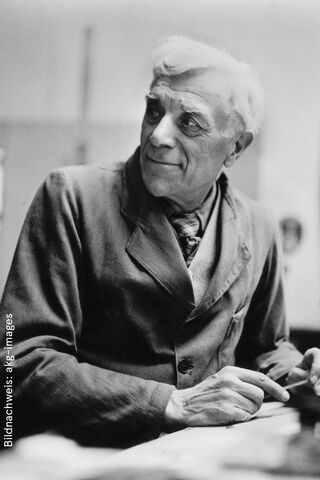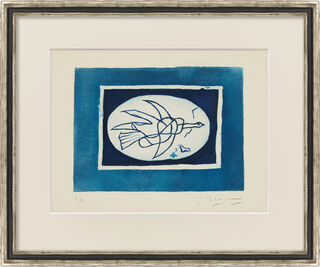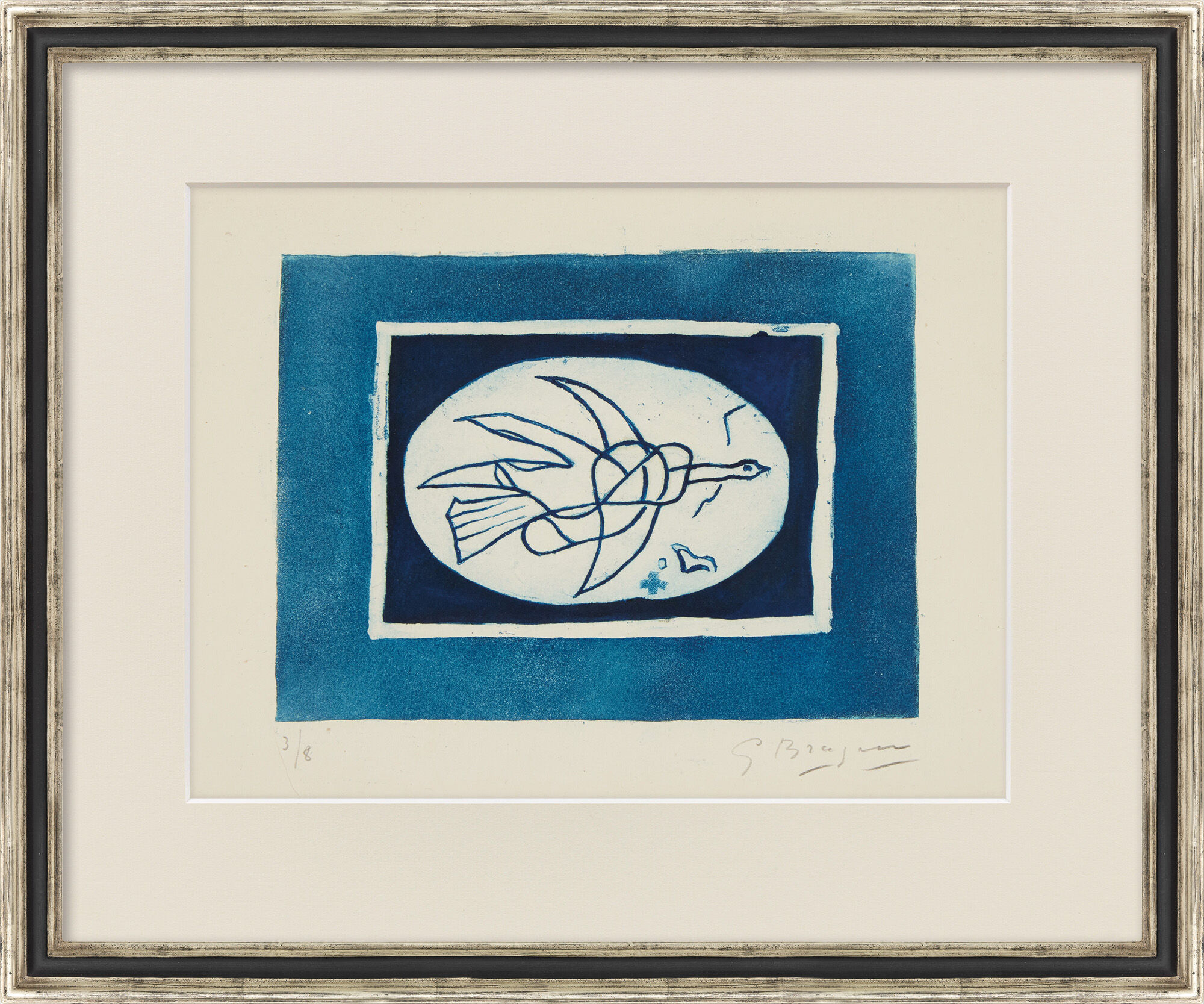Picture "Oiseau bleu (Oiseau IV)" (1952) New


Picture "Oiseau bleu (Oiseau IV)" (1952) New
Quick info
limited, 8 copies | numbered | signed | etching on velour paper | framed | size 30,5 x 36,5 cm
Detailed description
Picture "Oiseau bleu (Oiseau IV)" (1952)
We're sorry, but there is no English translation for this item yet. If you are interested in the size or the material of this product, please have a look at the German description as stated below.
Gegen Ende seiner künstlerischen Laufbahn wurde der fliegende Vogel in den Arbeiten von Georges Braque zu einem zentralen Motiv. Auch in früheren Jahren tauchen innerhalb von Braques Stillleben bereits Vögel auf, ab den 1950er-Jahren wandeln sie sich jedoch zu einem eigenständigen Sujet. Eine Erklärung für Braques mehrere Jahre andauernde Faszination für diese Kreatur der Lüfte mag darin bestehen, dass sie stellvertretend für die intensive Beschäftigung des Künstlers mit dem dreidimensionalen Raum und dessen Übertragung auf die Fläche gesehen werden kann.
In einem Interview, das er 1958 dem französischen Kunsthistoriker Jean Leymarie für die Zeitschrift "Quadrum" gab, beschreibt Braque seinen Weg zu dieser Motivfindung: "1929 kam ich erstmals zu dem Motiv für eine Illustration von Hesiod. Ich hatte schon 1910 Vögel gemalt, doch waren sie in Stillleben eingebettet, wohingegen ich in meinen aktuellen Werken von Raum und Bewegung begeistert bin."
Das hier angebotene Werk "Oiseau bleu (Oiseau IV)" von 1952 zeigt die Figur eines Vogels in einer flachen, geometrischen Perspektive. Die Farblithografie stammt aus der streng limitierten und handsignierten Kleinstauflage von nur 8 Exemplaren.
Radierung, 1952. Auflage: 8 Exemplare auf Velinpapier, nummeriert und signiert. Werkverzeichnis Vallier 77. Motivgröße 19 x 29,5 cm. Blattformat 24 x 34 cm. Format im Rahmen 30,5 x 36,5 cm wie Abbildung.

About Georges Braque
1882-1963
Georges Braque, the revolutionary of modern art and a classic figure of French art, left behind a magnificent oeuvre of prints: around 300 etchings, copperplate engravings, lithographs, and book illustrations. His life's work bears witness not only to an extraordinary joy in experimentation but also to a highly idiosyncratic pictorial imagination and creative power.
Braque stated the following essential observation: "We must be content with discovery and renounce explaining. There is only one valuable thing in art: the thing you cannot explain. A work that does not have a magical effect is not a work of art."
Before the First World War, Cubism emerged in 1908 in France, with its founding fathers being Georges Braque, who was born in Argenteuil, Val-d'Oise on May 13, 1882, and his friend and companion Pablo Picasso. Returning from the war, however, Braque pursued different artistic paths from Picasso, which in turn linked him to Henri Laurens and Juan Gris.
The guitar, vases and tables were central motifs in the Cubist paintings. The pure colours that still dominated his early fauvist landscape paintings subside to a grey-brown colour palette. As an antithesis to Cubism, Braque developed the collages, creating a new pictorial reality with scraps of wallpaper and newspaper clippings. This was followed by landscapes again in the 1930s, which, however, bear witness to a still-life-like structure. From 1938 onwards, the traditional theme of the studio became important to the artist, enriched by the motif of birds with a mystical component.
In the last years of his life, the artist presented himself not only as a painter and sculptor but also as a jewellery designer. His "Bijou Braque" combined the art of jewellery with the aspiration of the artist. He incorporated Greek motifs into over 100 designs. A dozen of them were even purchased by France. His art was so highly regarded that, in 1961, he became the first artist to have an exhibition dedicated to him in the Louvre during his lifetime. When Braque died on August 31, 1963, in Paris, the French Minister of Culture, André Malraux, made his status clear once again: "He is at home in the Louvre with the same right as the Angel of Reims in his cathedral."
The overlaps and saturations in Braque's works do not appear intensely spatial but are an integral part of the picture plane. This is why his paintings appear aesthetic and sensitive. His works "activate" the sense of seeing, and the pictorial impression is always ambiguous. The motifs are dissolved into colourful and formal structures. The form has autonomy and, at the same time, is integrated into larger constellations. All major museums exhibit his work in prominent positions.
The field of graphic arts, that includes artistic representations, which are reproduced by various printing techniques.
Printmaking techniques include woodcuts, copperplate engraving, etching, lithography, serigraphy.


